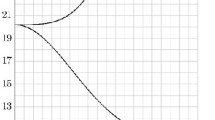Abstract
In this paper we consider a slab of viscous incompressible fluid bounded above by a free boundary, bounded below by a flat rigid interface, and acted on by gravity. The unique equilibrium is a flat slab of quiescent fluid. It is well-known that equilibria are asymptotically stable but that the rate of decay to equilibrium depends heavily on whether or not surface tension forces are accounted for at the free interface. The aim of the paper is to better understand the decay rate by studying a generalization of the linearized dynamics in which the surface tension operator is replaced by a more general fractional-order differential operator, which allows us to continuously interpolate between the case without surface tension and the case with surface tension. We study the decay of the linearized problem in terms of the choice of the generalized operator and in terms of the horizontal cross-section. In the case of a periodic cross-section we identify a critical order of the differential operator at which the decay rate transitions from almost exponential to exponential.
Similar content being viewed by others
References
Beale, J.T.: The initial value problem for the Navier–Stokes equations with a free surface. Commun. Pure Appl. Math. 34(3), 359–392 (1981)
Beale, J.T.: Large-time regularity of viscous surface waves. Arch. Ration. Mech. Anal. 84(4): 307–352 (1983/1984)
Beale, J.T., Nishida, T.: Large-time behavior of viscous surface waves. In: Masuda, K., Mimura, M. (eds.) Recent Topics in Nonlinear PDE, II (Sendai, 1984), Volume 128 of North-Holland Mathematics Studies, pp. 1–14. North-Holland, Amsterdam (1985)
Evans, L.C.: Partial Differential Equations. Volume 19 of Graduate Studies in Mathematics, 2nd edn. American Mathematical Society, Providence (2010)
Guo, Y., Tice, I.: Almost exponential decay of periodic viscous surface waves without surface tension. Arch. Ration. Mech. Anal. 207(2), 459–531 (2013)
Guo, Y., Tice, I.: Decay of viscous surface waves without surface tension in horizontally infinite domains. Anal. PDE 6(6), 1429–1533 (2013)
Hataya, Y.: Decaying solution of a Navier–Stokes flow without surface tension. J. Math. Kyoto Univ. 49(4), 691–717 (2009)
Nishida, T., Teramoto, Y., Yoshihara, H.: Global in time behavior of viscous surface waves: horizontally periodic motion. J. Math. Kyoto Univ. 44(2), 271–323 (2004)
Saito, H.: Global solvability of the Navier–Stokes equations with a free surface in the maximal \(L_p\)-\(L_q\) regularity class. J. Differ. Equ. 264(3), 1475–1520 (2018)
Author information
Authors and Affiliations
Corresponding author
Ethics declarations
Conflict of interest
The authors declare that they have no conflict of interest.
Additional information
Communicated by Y. Shibata.
Publisher's Note
Springer Nature remains neutral with regard to jurisdictional claims in published maps and institutional affiliations.
I. Tice was supported by a Simons Foundation Grant (#401468) and an NSF CAREER Grant (DMS #1653161). S. Zbarsky was supported by a National Science Foundation Graduate Research Fellowship.
Appendix A: Some Useful Analytic Facts
Appendix A: Some Useful Analytic Facts
Here we have compiled some analytic facts that we use in the paper. The forms given here are the forms we use, and no attempt has been made to state them in any additional generality.
First we record a simple version of the trace theorem.
Theorem A.1
(Trace). If \(\Omega =(0,\ell )\) or \(\Omega =\mathbb {R}^{N-1}\times (0,\ell )\) or \(\Omega =\mathbb {T}^{N-1}\times (0,\ell )\), then there is a continuous linear map \(Tr :H^1(\Omega )\rightarrow L^2(\partial \Omega )\) so that for \(f\in C^\infty (\bar{\Omega })\), we have \(Tr f=f\upharpoonright \partial \Omega \) and so that \(f, Tr f\) satisfy the integration by parts formula for all \(f\in H^1(\Omega )\).
Proof
This is a special case of Theorem 3 in Chapter 5.9 of [4]. \(\square \)
Next we record a version of the Poincaré inequality.
Theorem A.2
(Poincaré inequality.) If \(\Omega =(0,\ell )\) or \(\Omega =\mathbb {R}^{N-1}\times (0,\ell )\) or \(\Omega =\mathbb {T}^{N-1}\times (0,\ell )\), then there is some constant \(C>0\) so that for all \(f\in H^1(\Omega )\) satisfying \(f=0\) on \(\{y=0\}\),
Proof
For \(\mathbb {R}^{N-1}\times (0,\ell )\) and \(\mathbb {T}^{N-1}\times (0,\ell )\), it follows from the Poincaré inequality for \((0,\ell )\), which in turn follows from integration and Minkowski’s inequality. \(\square \)
Next we record a version of Korn’s inequality.
Theorem A.3
(Korn’s inequality). If \(\Omega =\mathbb {R}^{N-1}\times (0,\ell )\) or \(\Omega =\mathbb {T}^{N-1}\times (0,\ell )\), then there is some constant \(C>0\) so that for all \(f\in H^1(\Omega )\) satisfying \(f=0\) on \(\{y=0\}\), we have
Proof
For a proof, see [1], Lemma 2.7. \(\square \)
Finally, we record a result about time derivatives.
Theorem A.4
If v is a complex-valued function satisfying \(v\in L^2_T({H^1_\xi }(0,\ell ))\) and \(\partial _t v\in L^2_T({H^1_\xi }^*(0,\ell ))\), then \(v\in C([0,T];L^2(0,\ell ))\) and
The same holds if we replace \({H^1_\xi }\) with \({H^1_{\xi ,s}}\). Also, if v is a complex-valued function satisfying \(v\in L^2_T({{{}_0{H}^1}}(\Omega ))\) and \(\partial _t v\in L^2_T({{{}_0{H}^1}}^*(\Omega ))\), then \(v\in C([0,T];L^2(\Omega ))\) and
The same holds if we replace \({{{}_0{H}^1}}\) with \({{{}_0{H}^1_{\mathrm{sol}}}}\).
Proof
This is proved in the same manner as Theorem 3 in Chapter 5.9 of [4]. \(\square \)
Rights and permissions
About this article
Cite this article
Tice, I., Zbarsky, S. Decay of Solutions to the Linearized Free Surface Navier–Stokes Equations with Fractional Boundary Operators. J. Math. Fluid Mech. 22, 48 (2020). https://doi.org/10.1007/s00021-020-00512-8
Accepted:
Published:
DOI: https://doi.org/10.1007/s00021-020-00512-8



